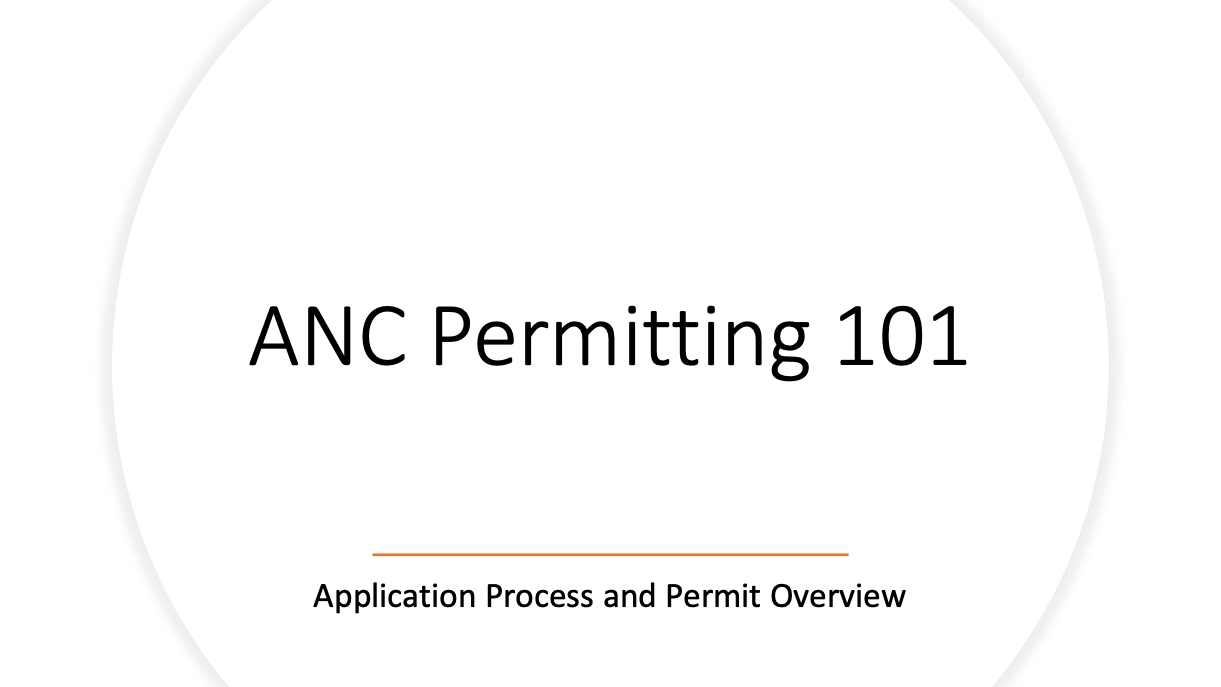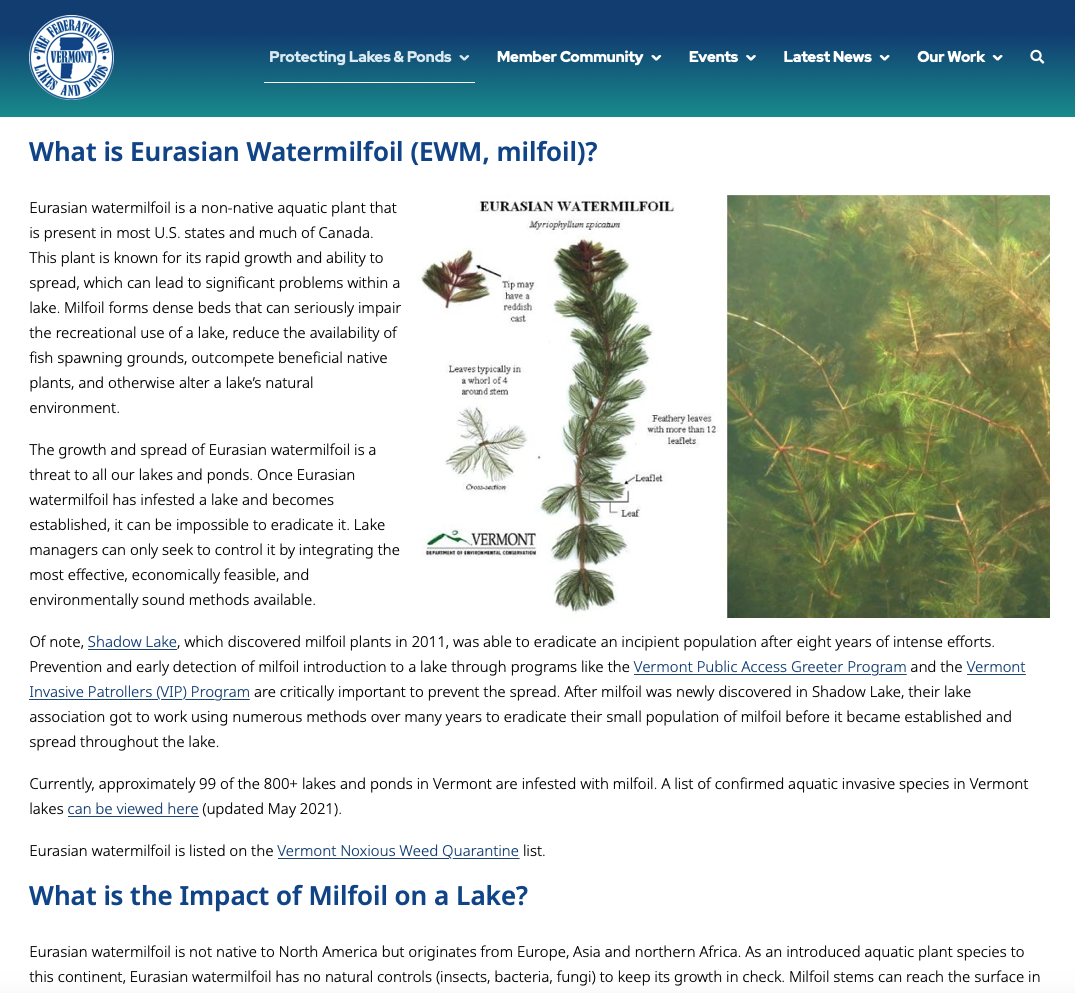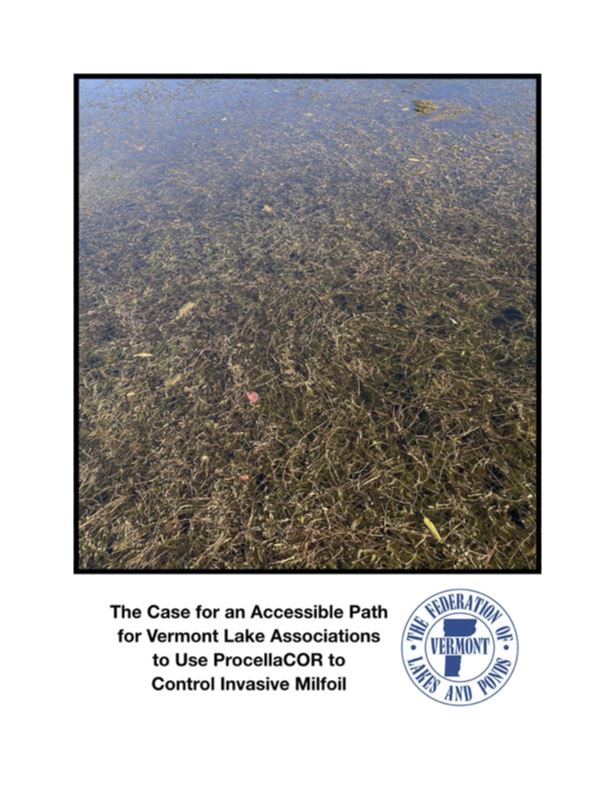Hello LSC.
We'd like to take some time today to inform you about some recent activity in the Vermont Legislature that could have an impact on the Lake St. Catherine Association's Milfoil Control Program.
As you may be aware, the Vermont legislature has created an Aquatic Nuisance Control Study Committee with the passing of Act 57 (H.31). From the Act 57 Committee’s website:
"The Aquatic Nuisance Control Study Committee was created to assess the environmental and public health effects of the use of pesticides, chemicals other than pesticides, biological controls, and other controls in comparison to the efficacy of their use in controlling aquatic nuisances recommendations regarding whether and when pesticides, chemicals other than pesticides, or biological controls should be used to control aquatic nuisances in Vermont in a report to the VT General Assembly on or before December 15, 2023."
As introduced, the intent of H.31 was to institute a 'moratorium' on pesticide use (notably carving out an exception to allow lampricide use to control lampreys in Lake Champlain), along with the creation of a study committee to summarize pesticide use, safety, effectiveness, use recommendations, and impact on non-target species.
Many lake associations, including the LSCA, the Federation of Vermont Lakes and Ponds (FOVLAP), and the DEC testified against this bill which looked to eliminate one of the safe and effective tools available to control Eurasian watermilfoil (milfoil, EWM).
Thankfully, the 'moratorium' was removed, but the scope of the study committee was expanded, and the bill was passed. The study committee will now additionally look at the existing Vermont statute permitting herbicide use (10 V.S.A. § 1455), and make recommendations for changes, if any. Study committee members include representatives from the DEC, Fish and Wildlife, Department of Health, a UVM Aquatic Biologist, a UVM Public Health Expert, and a member from the State House and State Senate.
Members of the LSCA have been attending the public meetings of the study committee, and we have submitted comments to them. We urged them to consider the tremendous amount of volunteer effort put forth by lake associations like the LSCA, as we work to preserve, protect, and maintain Lake St. Catherine and Vermont's lakes and ponds for all Vermonters and our visitors through our aquatic invasive species prevention control efforts, and our numerous water quality improvement projects. We asked that changes they propose, if any, to the already rigorous permitting process, will be based on the facts and the science, and not by those who seek to influence the process by providing misleading and false information, and that lake associations continue to have access to regulated, safe, and effective use of herbicides as a tool to maintain control of Eurasian watermilfoil in infested waterbodies.
As mentioned above, there has been a lot of misinformation about milfoil, ProcellaCOR, and the permitting process in online postings, newspaper commentaries, and during testimony given during the H.31 hearings.
So, we'd like to share a few publications and webpages with you which deal directly with this recent misinformation, while also providing fact-based information about milfoil, milfoil control, ProcellaCOR, and the permitting process. We hope you will give them a few minutes of your time.
1. Vermont DEC White Paper: "Permitting Aquatic Herbicide Projects in Vermont"
The Vermont DEC describes that the purpose of this document is to:
- Provide background information about DEC’s Aquatic Nuisance Control (ANC) permitting program, with a specific focus on aquatic herbicide projects;
- Identify some of the recent findings related to ProcellaCOR; and
- Provide a Q&A section on this topic reflecting common questions that DEC receives about our ANC permitting program
2. Vermont DEC Presentation: "ANC Permitting 101"
This presentation goes into great detail about the lengthy and rigorous process lake associations like the LSCA goes through to apply for a permit, what it takes to receive a permit, and what conditions and reporting requirements are included in approved permits. It also discusses the ongoing work that is needed on a yearly basis after the permit is approved.

3. Federation of Vermont Lakes and Ponds Webpage: "Eurasian watermilfoil"
This new webpage from FOVLAP talks about what milfoil is, what it does when it's introduced into a lake, prevention and early detection, control, and an FAQ section which deals directly with recent misinformation on milfoil, ProcellaCOR, and the permitting process you may have come across online or in newspaper commentaries.

4. Federation of Vermont Lakes and Ponds White Paper: "The Case for an Accessible Path for Vermont Lake Associations to Use ProcellaCOR to Control Invasive Milfoil"
This white paper was recently submitted to the Act 57 study committee. We thank FOVLAP for their work on this document as they make the case that the permitting application and review process remains rigorous but without unjustified new burdens.

An increasing share of the burden of preserving Vermont’s lakes and ponds falls on the volunteer associations, who must address a host of challenges to ensure the protection and the long-term health of these vital Vermont aquatic resources. Currently, management of invasive milfoil is Vermont’s most pressing AIS problem. The current regulations governing this management provides a means to manage milfoil with a high but sustainable cost and with a bearable permitting burden.
Ongoing action is needed to care for and protect Vermont lakes and ponds from the threat of milfoil and other AIS. The Act 57 Study Group’s recommendations for changing herbicide use permit regulations should carefully consider the concerns of the volunteer organizations who are passionately devoting time and resources to milfoil management. The State of Vermont has the statutory responsibility to preserve the public waters of the state. This common goal leads to a vital partnership between the State and the associations. An effective partnership can improve lake health, avoid loss of lakeshore property values, and continue to attract the robust tourist economy that Vermont lakes and ponds provide.
If the Act 57 Study Committee findings result in a delay or in significant changes to the permitting process that make the process yet more complex and burdensome, many milfoil infested lakes with active, successful, long term management programs (like Lake St. Catherine) could be negatively impacted, as they seek ANC permit renewals for ProcellaCOR. There would be similar negative impacts to those lakes that will, out of necessity, newly seek herbicide permits to control growing infestations.
We ask that you take some time to read through these resources. If you'd then like to take a step to help support the LSCA, and other lake associations that are working to control milfoil infestations, please consider writing in to the study committee to show your support of the LSCA, and let them know that lake associations should continue to have access to regulated, safe, and effective use of herbicides as a tool to maintain control of Eurasian watermilfoil. Comments can be sent to the study committee by sending them to this address: anr.wsmdlakes@vermont.gov with 'Act 57 Study Committee' in the subject line.
As mentioned above, the study committee's report is due on December 15th.
If you have any questions, please reach out to us, we'd be happy to discuss these issues with you. Email us at: info@lakestcatherine.org.
Thank you for your support of the LSCA!